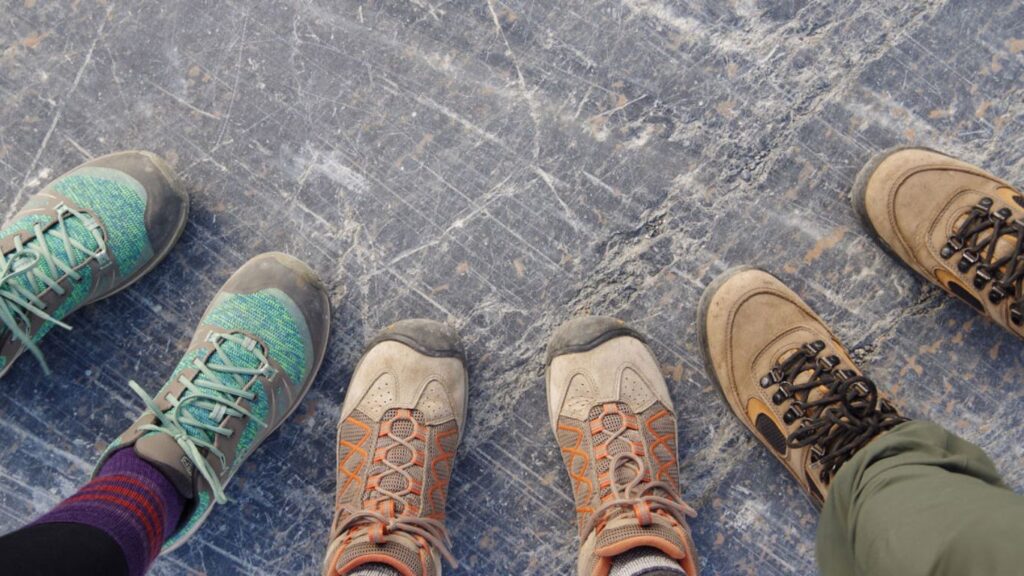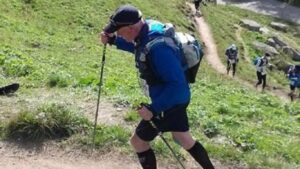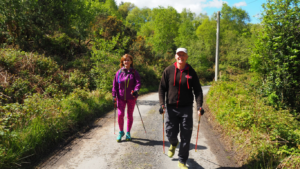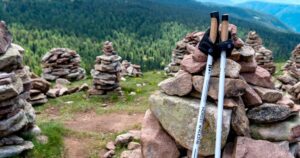The most important thing is overall comfort for you. Always try shoes on in a shop that specialises in walking and hiking, there are some local suggestions at the end of this page. If you find a style that works well for you then it is a good idea to buy a second pair as manufacturers often change styles. I have often got my second pair at half price as they were being discontinued
Shoes or Boots
For Nordic Walking you need good ankle flexibility and therefore walking shoes can work better but if you have weak ankles or are walking over rough terrain boots can be a better option.
Walking shoes have more flexible soles than walking boots, but walking boots offer more support for your foot and especially ankle protection. Like most things, it is a question of finding the right balance of flexibility vs protection for your particular feet.
What to Look For
Shoes for walking are going to have a huge impact on both your comfort and ultimate performance. Walking can involve many hours spent on your feet, so you need to have the right pair of shoes that fit you well and offer you the proper arch support.
There isn’t a one size fits all type of shoe when it comes to picking out the best shoes for walking, but you will need to make sure the shoe you select has plenty of cushioning for lengthy outdoor treks.
Shoe Size
You will need to consider the width and length of any shoes you are looking at before making your selection. You do not want a shoe that is so narrow it starts to pinch your feet, but you do not want the shoes to be so wide that your feet are slipping around rendering you unstable.
The toe box needs to be elevated enough that your toes have sufficient room and you do not have to worry about bunions forming.
I tend to buy shoes half to one size larger than my regular shoes but trying on is essential.
Support
The way your muscles, bones, tendons, and ligaments are aligned determines the way your arches are formed. When you walk, those arches distribute the weight of your body on your feet. If you do not have the right support and the weight is not evenly distributed, you could risk grave discomfort and even injury.
If you have neutral arched feet that are not particularly flat or arched, look for shoes with very firm midsoles and straight or partially curved soles providing quality support for the rear of your foot.
If you have low arches or flat feet, you will be at greater risk of muscular strain and joint issues, so, you will want to pick a walking shoe with a straight sole and footprint that stabilizes your feet and helps reduce the shock of impact.
If you have high arches, your feet will be prone to feeling the shock impact more than they otherwise wood, so you will need to select the best shoes for Nordic walking with extra firm arch support. A curved sole that conforms to your arch is also a key feature to look for.
Staff in the shops should be able to help you with all of this – if not then go to a different store.
Water Resistant
If you can possibly afford it, go for a waterproof shoe or boot. Gore-tex or similar waterproof membranes allow your foot to breath whilst preventing water ingress. If you cannot afford waterproof shoes, buy some waterproof socks! The disadvantage of waterproof shoes is if you find yourself wading through rivers it takes longer for the water to escape! If you cannot afford waterproof shoes, buy some waterproof socks! The disadvantage of waterproof shoes is if you find yourself wading through rivers it takes longer for the water to escape!
Flexible & Grippy Soles
Good sole flexibility is important, as part of walking technique is to roll through from the heel to toe, pushing off actively with the toe.
Boots become more flexible as you wear them in, but try and choose a pair with good pliability at the outset. It makes the walking action so much more effective. Also check the tread – you want something with a good grip across grass, mud and stony ground. Ask the sales assistant for help on this as boots have different outsoles and lug patterns depending on what the boot is primarily designed for. Vibram soles are the benchmark for quality, but many manufacturers are now using their own, similar brand.
Cushioning
Make sure your shoe/boot has good heel cushioning as good walking technique involves a heel strike. They should not rub or slip at the heel when the foot rolls through the stride and your toe should not hit the toe box and the end. If any of this happens, you are walking towards blisters
Weight
Try to buy shoes as light as possible otherwise you will be even more tired at the end of a long walk, with sore hip flexors and knees
Ankle Height
For many the ankle is a vulnerable area, so the height and rigidness of a boot’s ankle support is a big deal. The tighter the boot sits around your ankle, the more support it gives that area, but it comes at the cost of restricted freedom of movement and possible overheating. The way a boot is laced is also surprisingly important. The closer the lacing starts towards the toe the better you will be able to mould it to your foot. Particularly useful if you have wide or narrow feet.
Shoe Care
Look after your footwear. As with most things in life, the more care you take of your footwear the better it will serve you and the longer it will last. Yes, buy Nikwax if buying leather boots (or whatever it is that the shop assistant recommends) and apply it regularly. Apparently, as soon as water stops ‘balling’ on your footwear, it is time to re-proof it. If you don’t, this will happen: the material will get saturated, which will impair its breathability, which will damage the waterproof membrane (which will negate your warranty), which will leave you with wet feet and a bill for new shoes.
Keep your receipt and do not put up with a pair of faulty shoes/boots. Most manufacturers guarantee their footwear against manufacturing faults for a year and Gore-Tex and fabrics often offer a lifetime guarantee. Take your shoes/boots back if you are not happy, even if you have had them for several months. Make sure you have looked after them though.
Summary
The gold standard for walking shoes or boots is to be:
- water resistant
- breathable, flexible
- comfortable
- supportive
- lightweight
- grippy
To get all of this in one pair of shoes or boots can be difficult so always prioritise comfort, support and grippy soles
What do we wear?
It is difficult for us to recommend particularly makes of shoes and boots for people as we are all individuals with different requirements. Tony and I both wear Salomon Speed Cross trail running shoes for both winter and summer Nordic Walking.
Other makes worth a look at are:
Merrell and Scarpa who do both boots and shoes.
Local Shops
ENNIS
Carmody Shoes – Bank Place
Venture Out – Parnell St
LIMERICK
Mountain Warehouse – O’Connell St.
Emerald Alpine -Roches St
Radar Stores – Foxes Bow
GALWAY
Call of the Wild – Eglington St
Happy Walking!







